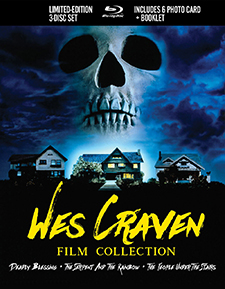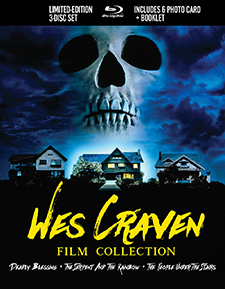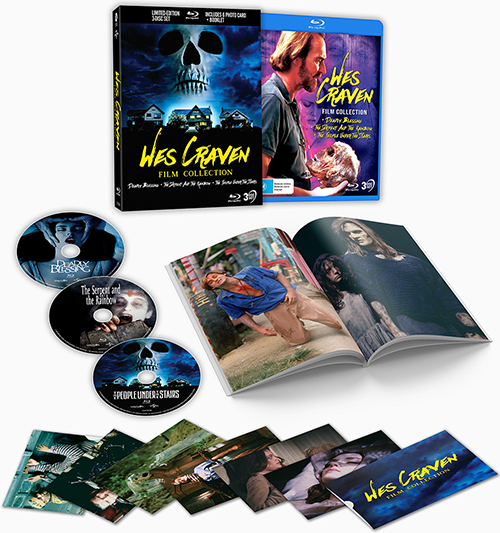Wes Craven Film Collection (Blu-ray Review)

Director
Wes CravenRelease Date(s)
1981-1991 (April 24, 2024)Studio(s)
United Artists/Universal Pictures (Via Vision Entertainment)- Film/Program Grade: See Below
- Video Grade: See Below
- Audio Grade: See Below
- Extras Grade: A-
- Overall Grade: B
Review
[Editor’s Note: This is a Region-Free Australian import.]
Before Wes Craven became synonymous with a certain burned-up, fedora-wearing, razor-fingered horror villain, he made a string of low budget horror films, some of which fell into obscurity, and all of which became genre hallmarks. 1981’s Deadly Blessing is one of those films, and once you see it, it will be immediately clear why it slipped between the cracks. On the one hand, there’s overbearing religious fanaticism, and the other, horror elements that don’t make a whole lot of sense at times. But more than anything, Deadly Blessing is a curiosity piece.
Could it be that the leader (Ernest Borgnine) of an Amish community (or Hittites as they’re referred to in the film) is going to extreme lengths to stamp out all evil in his neck of the woods, or is it something else entirely? The story plays out like a mystery, but there aren’t many red herrings or twists to be had. It plays up the cult aspects and attempts to drive home that it’s a member of the Amish community doing the killing. So much so that when those responsible are finally revealed, you might find yourself asking “Huh, where did that come from?,” leading to a complete re-evaluation of the story, and not necessarily in a positive way.
Still, Deadly Blessing is an intriguing film, even if it doesn’t entirely work. Seeing how deeply-rooted and devoted these characters are to their convictions versus everyone around them is really the whole ballgame. The horror aspects are is serviceable enough, but they’re not the entire focus. After all, where else in life are you going to see Ernest Borgnine rocking a fake Amish beard? It’s worth noting that Wes Craven also re-used ideas from this film. For instance, nearly all of the shots in the bathtub scene are identical to the ones seen later in A Nightmare on Elm Street. There’s also an early role inhabited by a young Sharon Stone, as well as an early musical score by James Horner. As such, Deadly Blessing isn’t without merit.
Deadly Blessing was shot by cinematographer Robert Jessup on 35mm film using Panavision Panaflex cameras and spherical lenses, finished photochemically, and presented in the aspect ratio of 1.85:1. The HD master presented here appears to be the same used for the Koch Media Blu-ray release, which is slightly more narrow than 1.85:1, and offers a bitrate that ranges from 30 to 40Mbps. As this is an older master, replete with a 2000s-era Universal logo at the top, detail is often lacking and the color palette isn’t as saturated as its Scream Factory Blu-ray counterpart. Blacks are often flat and lacking, but the image is stable, with only minor speckling leftover.
Audio is including in English 2.0 mono LPCM with optional subtitles in English SDH. Take note that the 5.1 option from the Scream Factory Blu-ray hasn’t been carried over. It’s the original soundtrack, if a bit restrained, but offers decent support for the various elements, especially James Horner’s score. Dialogue exchanges are clear, even if sound effects are a tad deficient.
DEADLY BLESSING (FILM/VIDEO/AUDIO): C+/B-/B-
Alternatively, The Serpent and the Rainbow is perhaps Wes Craven’s most fascinating project of all. Part of a three picture deal with Universal Pictures and Alive Films, the supernatural thriller was marketed in 1988 strictly as a horror film, perhaps to its detriment. Based upon the book of the same name by ethnobotanist Wade Davis, the film stars Bill Pullman as Dennis Alan, a man who travels to Haiti to investigate powerful hallucinogen drugs used by locals in their voodoo rituals. Davis’ real-life findings in Haiti, specifically those concerning a local man named Clairvius Narcisse (whom history has recorded as a purportedly factual Haitian voodoo zombie), was eventually criticized by the medical community, despite his insistence of their authenticity.
The film version uses many of these elements, but like most adaptations, gives it more of a narrative throughline. It’s starkly different than anything else Craven did in his career as a horror director, and feels very much like a nightmare that one can’t escape. Dennis Alan’s plight into the unknown is fascinating; being in constant danger at every turn and subjected to torture by the locals, it manages to keep you on the edge of your seat. Shot by cinematographer John Lindley (The Stepfather, Field of Dreams), mostly on location in Haiti at a time when political and internal unrest was taking place, it was a difficult film pull off, and it feels it. The outcome is eventually pushed into familiar Wes Craven territory, with hyper-realized visuals and terrifying imagery, but the atmosphere, make-up effects, and visuals make for an effective film.
The Serpent and the Rainbow was shot by cinematographer John Lindley on 35mm film using Arriflex cameras and spherical lenses, finished photochemically, and presented in the aspect ratio of 1.85:1. This HD master appears to pre-date the 2015 Scream Factory Blu-ray, which itself was a new transfer from the interpositive at the time. This presentation, like its predecessor, is slightly more narrow than the normal aspect ratio, but still manages to offer good picture quality with a nice saturation and contrast, with blacks that manage to have some depth to them. The bitrate runs somewhere between 25 to 40Mbps, give or take, and the opening and closing titles are very soft. Otherwise, the picture is stable with only minor speckling.
Audio is included in English 2.0 LPCM with optional subtitles in English SDH. It has some nice depth with clear, precise dialogue, and a muscular score from Brad Fiedel. Sound effects aren’t always top of the line, but it’s not an overly aggressive mix anyway; but it works well with the visuals, offering occasional stereo movement from time to time.
THE SERPENT AND THE RAINBOW (FILM/VIDEO/AUDIO): B+/B/B+
The third entry in Wes Craven’s Universal horror trilogy was 1991’s The People Under the Stairs, which was a mix of social issues, comedy, and horror—with a touch of Grand Guignol. It lives on as one of the most enduring horror films of its era, teetering on the edge of schlock, yet never failing to simultaneously get under your skin, give you characters to care about and root for, and make you laugh along the way—a rare feat.
Though initially dismissed by many, newer audiences have begun to appreciate what’s under the surface in The People Under the Stairs just as much as what’s above it. In some ways, it’s Wes Craven’s most aggressively down-and-dirty work since both The Last House House on the Left and The Hills Have Eyes; and at the same time, it’s a lot slicker with biting social commentary, and a dark sense of humor. It’s also a tad autobiographical when you know more about what Craven experienced as a child and how the character of Alice is treated in the story. However, his intention was to set up themes of racism in society, with the average-looking American home having more than just skeletons in its closets (literally, in this case).
There’s certainly fantastic elements to the story, which makes The People Under the Stairs more of a dark fable than a true, one-to-one reflection of American society. For instance, every attempt to expose the Robesons is thwarted whenever the police show up to question them, only to take them entirely at their word, which is not too far off the mark. Yet on the other hand, a neighborhood of poor black citizens descending upon a wealthy, white home would definitely have a different and more tragic outcome in today’s world (or in 1991, for that matter). Regardless, it’s satisfying to see the downtrodden come out on top... even if there’s a nagging part of your brain that acknowledges what the real-world consequences would actually be. As such, you just have to suspend your disbelief and go with it.
The People Under the Stairs was shot by cinematographer Sandi Sissel on 35mm film with Arriflex 35BL III cameras and spherical lenses, finished photochemically, and presented in the aspect ratio of 1.85:1. This HD master is an older one used by both Universal and Scream Factory for their 2013 and 2015 Blu-ray releases, respectively. Despite its lack of detail in comparison to its 4K Ultra HD counterpart, it still offers a worthy presentation with good depth, color, and contrast. The bitrate is tame, not rising much beyond 30Mbps, but then again, this is fairly dark film that doesn’t always require a maxed-out bitrate. It’s also stable with only minor speckling leftover.
Audio is included in English 2.0 LPCM with optional subtitles in English SDH. It’s worth noting that the Scream Factory 4K and Blu-ray releases also include a 5.1 option. On this track, dialogue is clear with excellent support for score and sound effects. There’s also some good stereo movement, but atmospherics play more of a role in this film.
THE PEOPLE UNDER THE STAIRS (FILM/VIDEO/AUDIO): B+/B+/A-
Via Vision’s Limited Edition Region-Free Blu-ray release of the Wes Craven: Film Collection contains 3 Blu-rays in a blue Amaray case, which is housed in a 3-D lenticular hardcase. Also included in the package is a set of 6 art cards featuring stills from each film and a 46-page booklet containing photos and the essay Wes Craven 1981-1991: A Decade of Deadly Blessings by John Harrison. Each disc contains the following extras:
DISC ONE: DEADLY BLESSING
- NEW Audio Commentary by Jarret Gahan
- Audio Commentary by Wes Craven and Sean Clark
- Say Your Prayers! with Michael Berryman (HD – 14:13)
- Secrets Revealed with Susan Buckner (HD – 13:05)
- Rise of the Incubus (HD – 6:40)
- So It Was Written with Matthew Barr & Glenn Benest (HD – 20:33)
- Theatrical Trailer (HD – 2:31)
- TV Spots (HD – 3 in all – 1:37)
- Radio Spots (HD – 5 in all – 2:35)
- Still Gallery (HD – 10 in all – :57)
New to this release is an audio commentary with film historian, critic, and festival programmer Jarret Gahan, who offers what he calls an “information-packed 100 minutes,” doing just that. He goes over the production history, its cast and crew, its eventual release and reception, and the thematics and ideas present in the film. The second commentary features Wes Craven and Horror’s Hallowed Grounds alumnus Sean Clark, who acts as a moderator. As Wes Craven is one of those directors who speaks so well that I could listen to him read his grocery list and be enthralled (not really, but you know what I mean), it’s an an invaluable track for his participation alone. Luckily, he and Clark have a good rapport with each other, offering various pieces of information about the film that are just as enlightening as they are sometimes provocative.
Other extras include five interviews: Say Your Prayers! with actor Michael Berryman, Secrets Revealed with actress Susan Buckner, Rise of the Incubus with creature designer John Naulin, and So It Was Written with writers Glenn Benest and Matthew Barr, all of which were conducted by Red Shirt Pictures. All of the participants offer their memories of the production and their feelings about the final product. Last is the film’s trailer, 3 TV spots, 5 radio spots, and a Still Gallery containing a total of 10 production photos and posters.
Almost none of the extras from the Arrow Video release of the film have been carried over, including an alternate audio commentary with Wes Craven, moderated by David Gregory; an introduction by Michael Berryman; The Deadliest Director, an interview with Wes Craven; Craven Images, an interview with Michael Berryman; Deadly Desires, an interview with Glenn Benest; a pair of Easter Eggs, one of Glenn Benest speaking about the film’s poster, and the other with Michael Berryman speaking about his recent film projects; and a 16-page insert booklet containing an essay about the film by Kim Newman.
DISC TWO: THE SERPENT AND THE RAINBOW
- NEW Audio Commentary by Alexandra Heller-Nicholas
- Audio Commentary by Bill Pullman and Rob Galluzzo
- The Making of The Serpent and the Rainbow (HD – 23:57)
- Theatrical Trailer (Upscaled SD – 1:17)
First is a new audio commentary with film critic and author Alexandra Heller-Nicholas, who offers an exhaustive examination of the film, providing plenty of context as she explores its content and background, while also highlighting much of the critical reaction to it. The 2016 audio commentary with Bill Pullman, moderated by producer Rob Galluzzo, runs for a little over half of the film since Pullman doesn’t have enough time to finish the chat before leaving to do another film. Regardless, it’s still a candid and fascinating little back and forth, especially in absence of any comments from Wes Craven himself. Reed Kaplan’s The Making of The Serpent and the Rainbow features interviews with cinematographer John Lindley, Bill Pullman, author Wade Davis, and special effects artists Dave Anderson and Lance Anderson. Last is the film’s trailer.
A few extras from previous releases are missing. The Scream Factory Blu-ray release included a single TV spot and a Still Gallery, while the Koch Media Blu-ray release contains several TV spots, The Directors: The Films of Wes Craven TV episode, The Making of The Serpent and the Rainbow production-era featurette, and profiles on Wes Craven and Wade Davis.
DISC THREE: THE PEOPLE UNDER THE STAIRS
- NEW Audio Commentary by Craig Martin
- Audio Commentary by Wes Craven and Michael Felsher
- Audio Commentary by Brandon Adams, A.J. Langer, Sean Whalen, and Yan Birch
- House Mother with Wendy Robie (HD – 19:26)
- House of Horrors with Director of Photography Sandi Sissel (HD – 16:09)
- Settling the Score with Don Peake (HD – 10:13)
- What Lies Beneath: The Effects of The People Under the Stairs (HD – 15:02)
- Behind-the-Scenes Footage (SD – 6:39)
- Vintage Making-Of Featurette (Upscaled SD – 3:43)
- Original Storyboards (HD – 65 in all – 6:55)
- Still Gallery (HD – 49 in all – 4:17)
- Theatrical Trailer (Upscaled SD – 1:14)
- TV Spots (Upscaled SD – 3 in all – 1:21)
New to this release is an audio commentary with film professor Craig Martin, who mostly dives into the film’s thematics, putting forth that it’s an unheralded masterpiece and should be recognized as such. In the terrific 2015 audio commentary with Wes Craven, moderated by Michael Felsher, the two have a very nice rapport during an extended Q&A session while watching the film together. The last (also from 2015) features actors Brandon Adams, A.J. Langer, Sean Whalen, and Yan Birch, which is an extremely laid-back commentary with no moderator as the actors fall into the trap of simply watching the film, allowing great gaps of silence go by.
House Mother features an interview with actress Wendy Robie, who discusses her career in horror and on TV, speaking highly of Wes Craven and A.J. Langer. House of Horrors interviews director of photography Sandi Sissel, who talks about her working relationship with Wes Craven and how much she enjoys seeing the film today. Settling the Score talks to composer Don Peake about how he was brought in at the eleventh hour to replace Graeme Revell. What Lies Beneath speaks to KNB EFX Group founders Howard Berger, Robert Kurtzman, and Greg Nicotero about their special effects make-up work in the film. Nicotero then provides us with several minutes of raw Behind-the-Scenes Footage, mostly featuring the scene in which Daddy carves up and eats Leroy, showing a trimmed moment when he actually bites into a piece of flesh on camera. Last is a Vintage Making-Of Featurette; a set of 65 Original Storyboards, including portions of a deleted scene; a Still Gallery containing 49 stills of behind-the-scenes photos, promotional photos, press photos, and posters; and the film’s trailer.
Not carried over from the Scream Factory 4K UHD release is a set of materials from Arrow Video’s 2013 Blu-ray release, including an audio commentary with Brandon Adams, moderated by Calum Waddell; Fear Freud and Class Warfare, an interview with Wes Craven; Behind Closed Doors, an interview with actress A.J. Langer; Silent But Deadly, an interview with actor Sean Whalen; and Under the Floorboards, an interview with screenwriter Jeffrey Reddick. Also not included from the Koch Media Blu-ray release is an audio commentary with Wes Craven, moderated by Calum Waddell.
Wes Craven: Film Collection offers a nice sampling of some of Wes Craven’s filmography, especially for the uninitiated. Though there are other options for these films in the US and elsewhere, it still manages to offer fine presentations, as well as a few additional extras, in an attractive package. Even so, this is likely a set that only hardcore collectors will want.
- Tim Salmons
(You can follow Tim on social media at these links: Twitter and Facebook. And be sure to subscribe to his YouTube channel here.)


